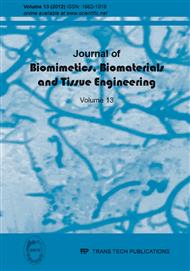[1]
M. Texon. A hemodynamic concept of atherosclerosis with particular reference to coronary occlusion. AMA Arch Intern Med. (1957) 99 (3) 418-27.
DOI: 10.1001/archinte.1957.00260030100010
Google Scholar
[2]
A.G. May, J. A De Weese, C. B Rob. Hemodynamic effects of arterial stenosis. Surgery, (1963) 53, 513-24.
Google Scholar
[3]
D. Hershey, S. J Cho. Blood flow in rigid tubes: Thickness and slip velocity of plasma film at the wall. J. Appli. Physiol. (1966) 21 (1) 27-32.
DOI: 10.1152/jappl.1966.21.1.27
Google Scholar
[4]
D. F Young. Effects of a time-dependent stenosis on flow through a tube. J. Eng. Ind. Trans. ASME. (1968) 90: 248-254.
Google Scholar
[5]
J. H Forrester, D. F Young. Flow through a converging diverging tube and its implications in occlusive vascular disease. J. Biomech. (1970) 3 (3): 297-316.
DOI: 10.31274/rtd-180814-349
Google Scholar
[6]
C. G Caro, J. M Fitz-Gerald, R. C Schroter. Atheroma and arterial wall shear observation, Correlation and proposal of a shear dependent mass transfer mechanism for Atherogenesis. Proc. R. Soc. (1971) 177 (1046): 109-59.
DOI: 10.1098/rspb.1971.0019
Google Scholar
[7]
D. L Fry. Localizing factor in arteriosclerosis, In: Atherosclerosis and Coronary Heart Disease, New York: Grune Stratton. 85, (1972).
Google Scholar
[8]
D. F Young, F. Y Tsai. Flow characteristics in models of arterial stenosis-II, unsteady flow. J. Biomech. (1973) 6 (5): 547-59.
Google Scholar
[9]
J. S Lee. On the coupling and detection of motion between an artery with a localized lesion and its surrounding tissue. J. Biomech. (1974) 7 (5): 403-9.
Google Scholar
[10]
R. L Kirkeeide, D. F Young, N. R Cholvin. Wall vibrations induced by flow through simulated stenos arteries. J. Biomech. (1977) 10 (7): 431-41.
DOI: 10.1016/0021-9290(77)90020-3
Google Scholar
[11]
S. E Charm, G. S Kurland. Viscometry of human blood for shear rate of 100, 000sec-1. Nature. (1965) 206 (4984): 617-8.
DOI: 10.1038/206617a0
Google Scholar
[12]
D. Hershey, R. E Byrnes, R. L Deddens, A. M Roa. Blood rheology: Temperature dependence of the power law model. Paper presented at A.I. Ch.E. Boston (1964).
Google Scholar
[13]
R. L Whitmore. Rheology of the circulation, Pergamon Press, New York (1968).
Google Scholar
[14]
G. R Cokelet. The rheology of human blood. In Biomechanics, Ed. By Y.C. Fung, Englewood Cliffs: Prentice-Hall, (1972).
Google Scholar
[15]
M. M Lih. Transport Phenomena in Medicine and Biology. Wiley, New York, (1975).
Google Scholar
[16]
J. B Shukla, R. S Parihar, S. P Gupta. Biorheological aspects of blood flow through artery with mild stenosis: Effects of peripheral layer. Biorheology. (1990) 17 (5-6): 403-10.
Google Scholar
[17]
N. Casson. A flow equation for pigment oil suspensions of the printing ink type. In Rheology of disperse systems, Ed. Mill., C.C., London. (1959) 84-102.
Google Scholar
[18]
M. Reiner, G. W Scott Blair. The flow of the blood through narrow tubes. Nature, (1959) 184: 354-9.
DOI: 10.1038/184354a0
Google Scholar
[19]
M. La Barbera. Principles of design of fluid transport in zoology. Science, (1990) 249 (4972): 992-1000.
DOI: 10.1126/science.2396104
Google Scholar
[20]
K. Haldar. Effects of the shape of stenosis on the resistance to blood flow through an artery. Bull. Mathe. Biol. (1985) 47 (4): 545-550.
DOI: 10.1016/s0092-8240(85)90020-5
Google Scholar
[21]
G. Pontrelli. Blood flow through an axisymmetric stenosis. Proc. Inst Mech. Eng, Part H, J Eng Med., (2001) 215 (1): 1-10.
DOI: 10.1177/095441190121500101
Google Scholar
[22]
P. N Tandon, P. Nirmala, M. Tewari, U. S Rana. Analysis of nutritional transport through a capillary: Normal and stenosed. Computers and Mathematics with Applications. (1991) 22 (12): 3-13.
DOI: 10.1016/0898-1221(91)90142-q
Google Scholar
[23]
H. Jung, J. W Choi, C. G Park. Asymmetric flows of non-Newtonian fluids in symmetric stenosed artery. Korea-Australia Rheology Journal (2004) 16 (2): 101-8.
Google Scholar


